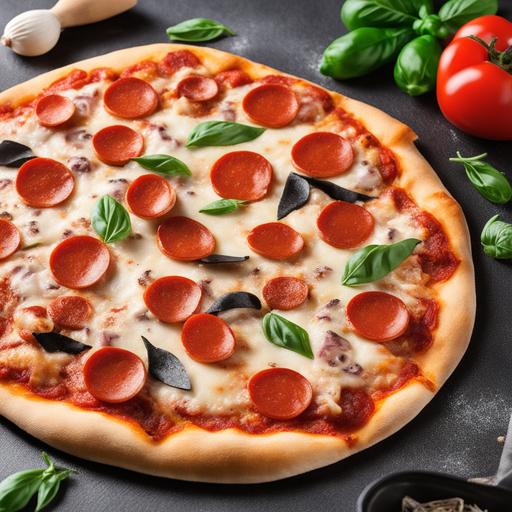
The Homemade Pizza Oven Recipe: A Complete Guide To Making The Perfect Pizza At Home
Are you a pizza lover like me who craves the irresistible taste of a hot, delicious pizza with a crispy crust and perfectly melted cheese? Look no further! In this comprehensive guide, we will take you on a culinary journey of creating your very own homemade pizza oven. We will delve into food science, culinary details, selection, cleaning, preparation, tips, variations, doneness checks, and everything else you need to know to make the most incredible homemade pizza you’ve ever tasted.
The Science Behind Pizza Perfection
Before we dive into the practical aspects, let’s explore the fascinating science that makes a pizza absolutely mouthwatering. Creating the perfect pizza dough requires understanding the magical interactions between flour, water, yeast, and salt. Gluten, a protein found in wheat flour, gives the dough its elasticity and structure. Combining the flour and water activates the gluten, and yeast releases carbon dioxide during fermentation, causing the dough to rise and become light and airy. Meanwhile, salt enhances the dough’s flavor and controls the yeast’s fermentation process.
Culinary Details: Choosing the Right Oven
When it comes to creating a homemade pizza oven, you have various options to consider. Let’s discuss a few popular choices:
1. Outdoor Wood-Fired Pizza Oven
If you’re a fan of authentic, rustic flavors, an outdoor wood-fired pizza oven is your best bet. These ovens use real wood as a fuel source, infusing the pizza with a slightly smoky aroma and a delectable charred crust. Wood-fired ovens reach incredibly high temperatures, allowing you to achieve that perfect Neapolitan-style pizza in just a few minutes.
2. Gas Pizza Oven
A gas pizza oven offers convenience without compromising on taste. With precise temperature control, these ovens ensure consistent baking results. Although they lack the traditional smoky flavor of wood-fired ovens, they are perfect for those seeking a quick and fuss-free pizza-making experience.
3. Countertop Electric Pizza Oven
For urban dwellers or individuals with limited outdoor space, a countertop electric pizza oven provides a practical solution. These compact ovens are designed to fit right on your kitchen counter, allowing you to enjoy the delightful taste of homemade pizza without the need for extensive installation or outdoor space.
Cleaning and Preparation: Setting Up for Success

Now that you’ve selected your ideal homemade pizza oven, it’s crucial to set it up correctly and keep it clean for optimal performance. Follow these steps to ensure a seamless preparation process:
1. Proper Oven Installation
If you’ve chosen an outdoor wood-fired or gas pizza oven, carefully follow the manufacturer’s instructions for a safe and secure installation. Check the oven’s chimney and flue regularly to prevent any potential blockages that may hinder proper ventilation.
2. Preheating the Oven
Begin by preheating your oven to the desired temperature. Whether you’re aiming for a blistering 800°F in a wood-fired oven or a precise 475°F in a gas or electric oven, allowing sufficient preheating time ensures even heat distribution and an evenly cooked pizza.
3. Cleaning and Maintenance
Regularly clean your homemade pizza oven to maintain its performance. Remove leftover ash or residues from wood-fired ovens and follow the specific cleaning instructions for gas or electric ovens. This not only ensures the longevity of your oven but also eliminates any unwanted flavors in your pizza.
Tips and Techniques for Pizza Perfection
Now that your homemade pizza oven is ready, let’s dive into some essential tips and techniques to create the most incredible homemade pizza:
1. The Perfect Dough
A great pizza starts with a perfect dough. Use high-quality bread flour for a chewier crust, or experiment with a combination of bread flour and Italian 00 flour for a lighter texture. Properly knead the dough to activate gluten and create a smooth, elastic consistency. Allow it to rise for an appropriate time, depending on the ambient temperature, to achieve the desired lightness.
2. Sauce Selection
The sauce is another critical element that complements the dough and toppings. Opt for high-quality crushed tomatoes or tomato puree, seasoned with aromatic herbs and spices. Balance the flavors with a touch of honey or sugar to offset the acidity.
3. Topping Creativity
Customize your pizza with a variety of toppings to create a unique culinary masterpiece. From classic Margherita with fresh mozzarella, basil, and tomatoes to more adventurous combinations like prosciutto, arugula, and shaved Parmesan, the possibilities are endless. However, remember that less is often more when it comes to toppings, allowing the flavors to shine without overwhelming the delicate balance of ingredients.
4. Cheese Melting Techniques
To achieve that gooey, melted cheese perfection, consider using a combination of high-moisture mozzarella and low-moisture aged cheeses such as Parmesan or Asiago. Shredding the cheese yourself provides better melting properties compared to pre-packaged grated cheese. Distribute the cheese evenly, leaving some space around the edges to allow the crust to crisp up beautifully.
5. Mastering Doneness Checks
One of the secrets to a perfectly cooked pizza is mastering doneness checks. Regardless of the oven type, keep a close eye on the pizza’s progress. The crust should have a golden-brown color with slight charred spots, while the cheese should be bubbly and beautifully melted. Using a pizza peel, gently lift the edge of the pizza to check for a crisp bottom crust before removing it from the oven.
Homemade Pizza Oven Recipe

After all the theory and practical tips, it’s time to dive into the delicious recipe itself. Below is a mouthwatering homemade pizza recipe to kick-start your pizza-making journey:
Homemade Pizza Dough
-
500g bread flour (or a mix of bread flour and Italian 00 flour)
-
325ml warm water
-
7g instant yeast
-
10g salt
-
1 tsp sugar
-
In a large bowl, combine the flour, yeast, salt, and sugar.
-
Gradually add the warm water and stir until a sticky dough forms.
-
Transfer the dough onto a lightly floured surface and knead for about 10 minutes until smooth and elastic.
-
Place the dough in a lightly oiled bowl, cover with a kitchen towel, and allow it to rise for 1-2 hours, or until doubled in size.
-
Punch down the risen dough and divide it into desired portions for individual pizzas.
-
Roll out each portion into a thin round shape, about 12 inches in diameter.
-
Proceed to add your desired sauce, toppings, and cheese, using the tips discussed earlier.
-
Preheat your homemade pizza oven to the desired temperature.
-
Transfer the prepared pizza onto a pizza peel or parchment paper and carefully slide it into the preheated oven.
-
Bake until the crust is golden brown, the cheese is perfectly melted, and the toppings are beautifully cooked.
-
Remove the pizza from the oven, allow it to cool for a few minutes, and indulge in your homemade pizza masterpiece.
Overcooking vs. Undercooking: Finding the Sweet Spot
Achieving the perfect doneness is a delicate balance. Overcooking your pizza can result in a burnt crust, dry toppings, or a tough texture. On the other hand, undercooking can leave you with a soggy, underwhelming pizza. Remember to keep a close eye on your pizza as it bakes, adjust the heat if necessary, and use your doneness checks as a guide to achieve that sweet spot between undercooked and overcooked.
Conclusion
Congratulations! You’ve now embarked on a culinary adventure that will revolutionize your pizza-making skills. From exploring the science behind pizza perfection to the practical aspects of setting up a homemade pizza oven, cleaning, preparation, tips, variations, doneness checks, and a delicious recipe, you’re well-equipped to create the most amazing homemade pizzas. So, gather your favorite ingredients, fire up your homemade pizza oven, and get ready to savor the mouthwatering flavors of your very own pizza masterpiece. Enjoy!
Sources
FAQS On Homemade Pizza Oven Recipe
What Are The Essential Ingredients For A Homemade Pizza Oven Recipe?
To make a homemade pizza oven, you will need flour, yeast, water, salt, olive oil, and your choice of toppings such as cheese, sauce, and various vegetables or meats.
What Type Of Oven Should I Use For A Homemade Pizza Oven Recipe?
You can use a traditional pizza oven, a wood-fired oven, a gas-powered pizza oven, or even a homemade pizza oven built with bricks or clay. The key is to achieve high temperatures for that perfect crispy crust.
How Do I Prepare The Dough For A Homemade Pizza Oven Recipe?
Start by mixing the flour, yeast, and salt in a large bowl. Gradually add the water and olive oil, kneading the dough until it becomes smooth and elastic. Let the dough rise in a warm place for about an hour, then divide it into individual pizza portions.
What Type Of Wood Should I Use For A Wood-fired Homemade Pizza Oven Recipe?
Hardwoods such as oak, maple, or hickory are ideal for a wood-fired homemade pizza oven. Avoid using softwoods like pine or cedar, as they can impart a bitter taste to the pizza.
How Long Should I Preheat The Oven For A Homemade Pizza Oven Recipe?
Preheat your homemade pizza oven for at least 30 minutes, or until it reaches a temperature of 500-600°F (260-315°C). This will ensure that the pizza cooks quickly and evenly, resulting in a perfect crispy crust and gooey melted cheese.


